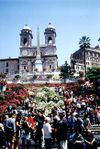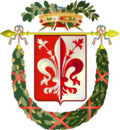Florence
| Florence Firenze |
|||
|---|---|---|---|
| — Comune — | |||
| Comune di Firenze | |||
 |
|||
|
|||
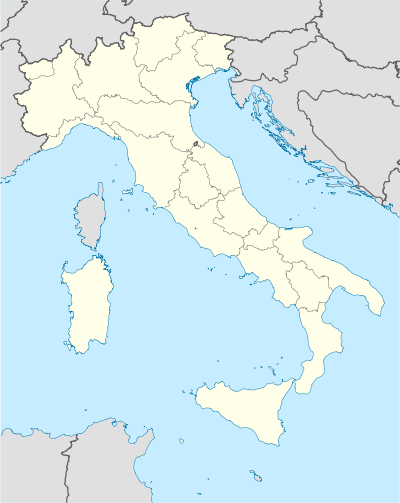 Florence
|
|||
| Coordinates: | |||
| Country | Italy | ||
| Region | Tuscany | ||
| Province | Florence (FI) | ||
| Government | |||
| - Mayor | Matteo Renzi (Democratic Party) | ||
| Area | |||
| - Total | 102.41 km2 (39.5 sq mi) | ||
| Elevation | 50 m (164 ft) | ||
| Population (30 April 2009)[1] | |||
| - Total | 368,362 | ||
| - Density | 3,596.9/km2 (9,316/sq mi) | ||
| Demonym | Fiorentini | ||
| Time zone | CET (UTC+1) | ||
| - Summer (DST) | CEST (UTC+2) | ||
| Postal code | 50121-50145 | ||
| Dialing code | 055 | ||
| Patron saint | John the Baptist | ||
| Saint day | 24 June | ||
| Website | Official website | ||
| Historic Centre of Florence* | |
|---|---|
| UNESCO World Heritage Site | |
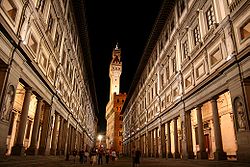 |
|
| State Party | |
| Type | Cultural |
| Criteria | i, ii, iii, iv, vi |
| Reference | 174 |
| Region** | Europe and North America |
| Inscription history | |
| Inscription | 1982 (6th Session) |
| * Name as inscribed on World Heritage List. ** Region as classified by UNESCO. |
|
Florence (Italian: Firenze listen, pronounced [fiˈrɛntse]; alternative obsolete spelling: Fiorenza, Latin: Florentia) is the capital city of the Italian region of Tuscany and of the province of Florence. It is the most populous city in Tuscany, with 367,569 inhabitants (1,500,000 in the metropolitan area).[2]
The city lies on the River Arno and is known for its history and its importance in the Middle Ages and in the Renaissance, especially for its art and architecture. A centre of medieval European trade and finance and one of the richest and wealthiest cities of the time,[3] Florence is considered the birthplace of the Italian Renaissance; in fact, it has been called the Athens of the Middle Ages.[4] It was long under the de facto rule of the Medici family. From 1865 to 1870 the city was also the capital of the Kingdom of Italy.
The historic centre of Florence attracts millions of tourists each year and was declared a World Heritage Site by UNESCO in 1982. Florence is widely regarded as one of the most beautiful cities in the world,[5][6] and its artistic,[7] historic and cultural heritage and impact in the world remains vast up to this day. The city has also a major European impact in music, architecture, education, cuisine, fashion, philosophy, science and religion. The historic centre of Florence contains numerous elegant squares (piazzas), Renaissance palaces (palazzi), academies, parks, gardens, churches, monasteries, museums, art galleries and ateliers. The city has also been nominated, according to a 2007 study, as the most desirable destination for tourists in the world.[8]
The city boasts a wide range of collections of art, especially those held in the Pitti Palace and the Uffizi, (which receives about 1.6 million tourists a year).[9] Florence is arguably the last preserved Renaissance city in the world[10] and is regarded by many as the art capital of Italy. It has been the birthplace or chosen home of many notable historical figures, such as Dante, Boccaccio, Leonardo da Vinci, Botticelli, Niccolò Machiavelli, Brunelleschi, Michelangelo, Donatello, Galileo Galilei, Catherine de' Medici, Antonio Meucci, Guccio Gucci, Salvatore Ferragamo, Roberto Cavalli, and Emilio Pucci.
Contents |
History
Florence has had a long and eventful history, being a Roman city, the birthplace of the Italian Renaissance (or the "Florentine Renaissance"), and being considered, according to the Encyclopædia Britannica as politically, economically, and culturally one of the most important cities in Europe and the world for around 250 years – from the 14th century to the 16th century.[11]
Such was the dominance on artistic and cultural grounds of Florence, that the language spoken there during the 14th century was, and still is, accepted as pan-Italian language. almost all the writers and poets in the Italian literature of the golden age are somewhat connected with Florence, leading ultimately to the adoption of the florentine above all the local dialects, as literary language of choice.[12]
Florentines reinvented money – in the form of the gold florin – which was the engine that drove Europe out of the "Dark Ages" - a term invented by Petrarch, a Florentine. They financed the development of industry all over Europe – from Britain to Bruges, to Lyon, to Hungary. They financed the English kings during the Hundred Years War. They financed the papacy, including the construction of Avignon and the reconstruction of Rome when the papacy returned from the Babylonian Captivity.
Florence was home to the Medici, one of history's most important noble families, who revolutionized high culture and the arts. They taught first the other Italians how to conduct state-craft, and then they taught the rest of the Europeans. Just to cite one example: Catherine de Medici (1519–1589), married Henry II of France (reigned 1547–1559). After he died, Catherine ruled France as regent for her young sons and was instrumental in turning France into Europe's first nation-state. She brought the Renaissance into France, introducing everything from the chateaux of the Loire to the fork. She also was to 16th and 17th century European royalty what Queen Victoria was to the 19th and 20th centuries. Her children included three kings of France, Francis II (ruled 1559–1560), Charles IX (ruled 1560–1574) and Henry III (ruled 1574–1589). Her children-in-law included a fourth king of France, Henry IV (ruled 1589–1610), plus Elizabeth of Habsburg, Philip II of Spain (of Armada fame), and Mary, Queen of Scots.
Roman origins
Florence was originally established by Julius Caesar in 59 BC as a settlement for his veteran soldiers. It was named Florentia ('the flourishing') and built in the style of an army camp with the main streets, the cardo and the decumanus, intersecting at the present Piazza della Repubblica. Situated at the Via Cassia, the main route between Rome and the north, and within the fertile valley of the Arno, the settlement quickly became an important commercial centre. The Emperor Diocletian is said to have made Florentia the seat of a bishopric around the beginning of the 4th century AD, but this seems impossible in that Diocletian was a notable persecutor of Christians.
In the ensuing two centuries, the city experienced turbulent periods of Ostrogothic rule, during which the city was often troubled by warfare between the Ostrogoths and the Byzantines, which may have caused the population to fall to as few as 1,000 people. Peace returned under Lombard rule in the 6th century. Florence was conquered by Charlemagne in 774 and became part of the Duchy of Tuscany, with Lucca as capital. The population began to grow again and commerce prospered. In 854, Florence and Fiesole were united in one county.
Second millennium
Margrave Hugo chose Florence as his residency instead of Lucca at about 1000 AD. The Golden Age of Florentine art began around this time. In 1013, construction began on the Basilica di San Miniato al Monte. The exterior of the baptistery was reworked in Romanesque style between 1059 and 1128. This period also saw the eclipse of Florence's formerly powerful rival Pisa (defeated by Genoa in 1284 and subjugated by Florence in 1406), and the exercise of power by the mercantile elite following an anti-aristocratic movement, led by Giano della Bella, that resulted in a set of laws called the Ordinances of Justice (1293).
Middle Ages and Renaissance
Rise of the Medici

Of a population estimated at 94,000 before the Black Death of 1348,[13] about 25,000 are said to have been supported by the city's wool industry: in 1345 Florence was the scene of an attempted strike by wool combers (ciompi), who in 1378 rose up in a brief revolt against oligarchic rule in the Revolt of the Ciompi. After their suppression, Florence came under the sway (1382–1434) of the Albizzi family, bitter rivals of the Medici. Cosimo de' Medici was the first Medici family member to essentially control the city from behind the scenes. Although the city was technically a democracy of sorts, his power came from a vast patronage network along with his alliance to the new immigrants, the gente nuova (new people). The fact that the Medici were bankers to the pope also contributed to their ascendancy. Cosimo was succeeded by his son Piero, who was, soon after, succeeded by Cosimo's grandson, Lorenzo in 1469. Lorenzo was a great patron of the arts, commissioning works by Michelangelo, Leonardo da Vinci and Botticelli. Lorenzo was also an accomplished musician and brought some of the most famous composers and singers of the day to Florence, including Alexander Agricola, Johannes Ghiselin, and Heinrich Isaac. By contemporary Florentines (and since), he was known as "Lorenzo the Magnificent" (Lorenzo il Magnifico).
Following the death of Lorenzo de' Medici in 1492, he was succeeded by his son Piero II. When the French king Charles VIII invaded northern Italy, Piero II chose to resist his army. But when he realized the size of the French army at the gates of Pisa, he had to accept the humiliating conditions of the French king. These made the Florentines rebel and they expelled Piero II. With his exile in 1494, the first period of Medici rule ended with the restoration of a republican government.
Savonarola and Machiavelli
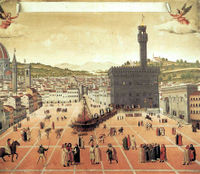
During this period, the Dominican monk Girolamo Savonarola had become prior of the San Marco monastery in 1490. He was famed for his penitential sermons, lambasting what he viewed as widespread immorality and attachment to material riches. He blamed the exile of the Medicis as the work of God, punishing them for their decadence. He seized the opportunity to carry through political reforms leading to a more democratic rule. But when Savonarola publicly accused Pope Alexander VI of corruption, he was banned from speaking in public. When he broke this ban, he was excommunicated. The Florentines, tired of his extreme teachings, turned against him and arrested him. He was convicted as a heretic and burned at the stake on the Piazza della Signoria on 23 May 1498.
A second individual of unusual insight was Niccolò Machiavelli, whose prescriptions for Florence's regeneration under strong leadership have often been seen as a legitimization of political expediency and even malpractice. Commissioned by the Medici, Machiavelli also wrote the Florentine Histories, the history of the city. Florentines drove out the Medici for a second time and re-established a republic on 16 May 1527. Restored twice with the support of both Emperor and Pope, the Medici in 1537 became hereditary dukes of Florence, and in 1569 Grand Dukes of Tuscany, ruling for two centuries. In all Tuscany, only the Republic of Lucca (later a Duchy) and the Principality of Piombino were independent from Florence.
18th and 19th centuries

The extinction of the Medici dynasty and the accession in 1737 of Francis Stephen, duke of Lorraine and husband of Maria Theresa of Austria, led to Tuscany's temporary inclusion in the territories of the Austrian crown. It became a secundogeniture of the Habsburg-Lorraine dynasty, who were deposed for the Bourbon-Parma in 1801, themselves deposed in December 1807 when Tuscany was annexed by France. Florence was the prefecture of the French department of Arno from 1808 to the fall of Napoleon in 1814. The Habsburg-Lorraine dynasty was restored on the throne of Tuscany at the Congress of Vienna but finally deposed in 1859. Tuscany became a province of the United Kingdom of Italy in 1861.
Florence replaced Turin as Italy's capital in 1865 and, in an effort to modernise the city, the old market in the Piazza del Mercato Vecchio and many medieval houses were pulled down and replaced by a more formal street plan with newer houses. The Piazza (first renamed Piazza Vittorio Emmanuele II, then Piazza della Repubblica, the present name) was significantly widened and a large triumphal arch was constructed at the west end. This development was unpopular and was prevented from continuing by the efforts of several British and American people living in the city. A museum recording the destruction stands nearby today. The country's first capital city was superseded by Rome six years later, after the withdrawal of the French troops made its addition to the kingdom possible. A very important role is played in these years by the famous café of Florence Giubbe Rosse from its foundation until the present day. "Non fu giammai così nobil giardino/ come a quel tempo egli è Mercato Vecchio / che l'occhio e il gusto pasce al fiorentino", claimed Antonio Pucci in the 14th century, "Mercato Vecchio nel mondo è alimento./ A ogni altra piazza il prego serra". The area had, however, decayed from its original medieval splendor.
20th century
After doubling during the 19th century, Florence's population was to triple in the 20th, resulting from growth in tourism, trade, financial services and industry.
During World War II the city experienced a year-long German occupation (1943–1944) and was declared an open city. The Allied soldiers who died driving the Germans from Tuscany are buried in cemeteries outside the city (Americans about 9 kilometres (6 mi) south of the city, British and Commonwealth soldiers a few kilometres east of the centre on the right bank of the Arno). In 1944, the retreating Germans decided to blow up the bridges along the Arno linking the district of Oltrarno to the rest of the city, thus making it difficult for the British troops to cross. However, at the last moment Charle Steinhauslin, at the time consulate of 26 countries in Florence convinced the German general in Italy that the Ponte Vecchio was not to be blown up, as it was too beautiful. Instead, an equally historic area of streets directly to the south of the bridge, including part of the Corridoio Vasariano, was destroyed using mines. Since then the bridges have been restored exactly to their original forms using as many of the remaining materials as possible, but the buildings surrounding the Ponte Vecchio have been rebuilt in a style combining the old with modern design. Shortly before leaving Florence, as they knew that they would soon have to retreat, the Germans murdered many freedom fighters and political opponents publicly, in streets and squares including the Piazza Santo Spirito.
In November 1966, the Arno flooded parts of the centre, damaging many art treasures. There was no warning from the authorities, who knew the flood was coming, except a phone call to the jewellers on the Ponte Vecchio. Around the city there are tiny placards on the walls noting where the flood waters reached at their highest point.
Geography
| Florence | ||||||||||||||||||||||||||||||||||||||||||||||||||||||||||||
|---|---|---|---|---|---|---|---|---|---|---|---|---|---|---|---|---|---|---|---|---|---|---|---|---|---|---|---|---|---|---|---|---|---|---|---|---|---|---|---|---|---|---|---|---|---|---|---|---|---|---|---|---|---|---|---|---|---|---|---|---|
| Climate chart () | ||||||||||||||||||||||||||||||||||||||||||||||||||||||||||||
|
||||||||||||||||||||||||||||||||||||||||||||||||||||||||||||
|
||||||||||||||||||||||||||||||||||||||||||||||||||||||||||||
Florence lies in a sort of basin among the Senese Clavey Hills, particularly the hills of Careggi, Fiesole, Settignano, Arcetri, Poggio Imperiale and Bellosguardo (Florence). The Arno river and three other minor rivers flow through it.
Climate
Florence is usually said to have a Mediterranean climate, although under the Köppen climate classification it may be borderline humid subtropical (Cfa).[14] It has hot, humid summers with little rainfall and cool, damp winters. Due to being surrounded by hills in a river valley, Florence can be hot and humid from June to August. Because of the lack of a prevailing wind, summer temperatures are higher than along the coast. The rain which does fall in summer is convectional. Relief rainfall dominates in the winter, with some snow. The highest officially recorded temperature was 42.6 °C (108.7 °F) in 26 July 1983 and the lowest was −23.2 °C (−9.8 °F) on 12 January 1985.[15]
| Climate data for Florence | |||||||||||||
|---|---|---|---|---|---|---|---|---|---|---|---|---|---|
| Month | Jan | Feb | Mar | Apr | May | Jun | Jul | Aug | Sep | Oct | Nov | Dec | Year |
| Average high °C (°F) | 10.1 (50.2) |
12.0 (53.6) |
15.0 (59) |
18.8 (65.8) |
23.4 (74.1) |
27.3 (81.1) |
31.1 (88) |
30.6 (87.1) |
26.6 (79.9) |
21.1 (70) |
14.9 (58.8) |
10.4 (50.7) |
20.1 (68.2) |
| Average low °C (°F) | 1.4 (34.5) |
2.8 (37) |
4.9 (40.8) |
7.7 (45.9) |
11.3 (52.3) |
14.7 (58.5) |
17.2 (63) |
17.0 (62.6) |
14.2 (57.6) |
10.0 (50) |
5.5 (41.9) |
2.4 (36.3) |
9.1 (48.4) |
| Precipitation mm (inches) | 73.1 (2.878) |
69.2 (2.724) |
80.1 (3.154) |
77.5 (3.051) |
72.6 (2.858) |
54.7 (2.154) |
39.6 (1.559) |
76.1 (2.996) |
77.5 (3.051) |
87.8 (3.457) |
111.2 (4.378) |
91.3 (3.594) |
910.7 (35.854) |
| Avg. precipitation days | 9.4 | 8.4 | 8.6 | 9.1 | 8.6 | 6.3 | 3.5 | 5.9 | 5.7 | 7.4 | 10.0 | 8.8 | 91.7 |
| Source: World Meteorological Organisation (United Nations) [16] | |||||||||||||
Subdivisions
The traditional subdivision of Florence into four quarters dates from the 14th century (that today compose the old town):
- Santa Maria Novella
- San Giovanni
- Santa Croce
- Santo Spirito
The modern administrative subdivision into five wards follows the boundaries of the traditional quarters in the outer areas, as can be seen on the maps:
Subdivision of Florence: The traditional quarters and current wards (Quartiere)

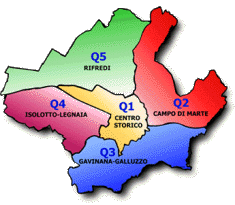
The five current administrative divisions with their neighbourhoods:
| Ward (Quartiere) |
Area (km²) |
Population (May 2006) |
Population density |
Neighbourhoods (frazioni) within ward |
|---|---|---|---|---|
| Quartiere 1 Historic Centre |
11.396 | 67,170 | 5,894 | San Jacopino · Il Prato · La Fortezza · Viali · Duomo–Oltrarno · Collina sud · San Gaggio |
| Quartiere 2 Campo di Marte |
23.406 | 88,588 | 3,784 | Campo di Marte–Le Cure · Viali · La Rondinella · Settignano · Collina nord · Bellariva–Gavinana |
| Quartiere 3 Gavinana/Galluzzo |
22.312 | 40,907 | 1,833 | Collina sud · Galluzzo · San Gaggio · Bellariva–Gavinana · Sorgane · Ponte a Ema |
| Quartiere 4 Isolotto/Legnaia |
16.991 | 66,636 | 3,921 | Argingrosso · Cintoia · I Bassi · Il Casone · Isolotto · La Casella · Legnaia · Le Torri · Mantignano · Monticelli · Pignone · San Lorenzo a Greve · Soffiano · San Quirico · Torcicoda · Ugnano |
| Quartiere 5 Rifredi |
28.171 | 103,761 | 3,683 | Castello–Le Panche · Piana di Castello · Pistoiese · Brozzi · Peretola · Il Lippi–Barsanti (Florence) · Firenze Nova · Novoli · Parco delle Cascine–Argingrosso · San Jacopino · La Fortezza · Careggi · Leopoldo–Rifredi · Collina nord · Viali |
| Florence | 102.276 | 367,062 | 3,589 |
Architecture

Florence is known as the "cradle of the Renaissance" (la culla del Rinascimento) for its monuments, churches and buildings. The best-known site and crowning architectural jewel of Florence is the domed cathedral of the city, Santa Maria del Fiore, known as The Duomo. The magnificent dome was built by Filippo Brunelleschi. The nearby Campanile (partly designed by Giotto) and the Baptistery buildings are also highlights. Both the dome itself and the campanile are open to tourists and offer excellent views; The dome, 600 years after its completion, is still the largest dome built in brick and mortar in the world.[17]
In 1982, the historic centre of Florence (Italian: centro storico di Firenze) was declared a World Heritage Site by the UNESCO for the importance of its cultural heritages. The centre of the city is contained in medieval walls that were built in the 14th century to defend the city after it became famous and important for its economic growth.
At the heart of the city, in Piazza della Signoria, is Bartolomeo Ammanati's Fountain of Neptune (1563–1565), which is a masterpiece of marble sculpture at the terminus of a still- functioning Roman aqueduct.
The River Arno, which cuts through the old part of the city, is as much a character in Florentine history as many of the people who lived there. Historically, the locals have had a love-hate relationship with the Arno — which alternated between nourishing the city with commerce, and destroying it by flood.
One of the bridges in particular stands out as being unique — The Ponte Vecchio (Old Bridge), whose most striking feature is the multitude of shops built upon its edges, held up by stilts. The bridge also carries Vasari's elevated corridor linking the Uffizi to the Medici residence (Palazzo Pitti). Although the original bridge was constructed by the Etruscans, the current bridge was rebuilt in the 14th century. It is the only bridge in the city to have survived World War II intact. His most notable claim to fame is the fact that it is the first example in the western world of a bridge built using segmental arches, that is, arches less than a semicircle, to reduce both span-to-rise ratio and the numbers of pillars to allow lesser encumbrance in the riverbed (being in this much more successful than the roman Alconétar Bridge)
The church of San Lorenzo contains the Medici Chapel, the mausoleum of the Medici family – the most powerful family in Florence from the 15th to the 18th century. Nearby is the Uffizi Gallery, one of the finest art museums in the world – founded on a large bequest from the last member of the Medici family.
The Uffizi itself is located at the corner of Piazza della Signoria, a site important for being the centre of Florence's civil life and government for centuries. (Signoria Palace is still home of the community government.) The Loggia dei Lanzi provided the setting for all the public ceremonies of the republican government. Many significant episodes in the history of art and political changes were staged here, such as:
- In 1301, Dante was sent into exile from here (commemorated by a plaque on one of the walls of the Uffizi).
- On 26 April 1478, Jacopo de'Pazzi and his retainers tried to raise the city against the Medici after the plot known as The congiura dei Pazzi (The Pazzi conspiracy), murdering Giuliano di Piero de' Medici and wounding his brother Lorenzo. All the members of the plot who could be apprehended were seized by the Florentines and hanged from the windows of the palace.
- In 1497, it was the location of the Bonfire of the Vanities instigated by the Dominican friar and preacher Girolamo Savonarola
- On 23 May 1498, the same Savonarola and two followers were hanged and burnt at the stake. (A round plate in the ground marks the spot where he was hanged)
- In 1504, Michelangelo's David (now replaced by a replica, since the original was moved indoors to the Accademia dell'Arte del Disegno) was installed in front of the Palazzo della Signoria (also known as Palazzo Vecchio).
The Piazza della Signoria is the location of a number of statues by other sculptors such as Donatello, Giambologna, Ammannati and Cellini, although some have been replaced with copies to preserve the priceless originals.
In addition to the Uffizi, Florence has other world-class museums. The Bargello concentrates on sculpture, containing many priceless works by sculptors including Donatello, Giambologna and Michelangelo. The Accademia dell'Arte del Disegno (often simply called the Accademia) collection's highlights are Michelangelo's David and his unfinished Slaves.
Across the Arno is the huge Palazzo Pitti, containing part of the Medici family's former private collection. In addition to the Medici collection, the palace's galleries contain many Renaissance works, including several by Raphael and Titian, large collections of costumes, ceremonial carriages, siver, porcelain and a gallery of modern art dating from the 18th century. Adjoining the palace are the Boboli Gardens, elaborately landscaped and with many interesting sculptures.
The Santa Croce basilica, originally a Franciscan foundation, contains the monumental tombs of Galileo, Michelangelo, Machiavelli, Dante (actually a cenotaph), and many other notables.
Other important basilicas and churches in Florence include Santa Maria Novella, San Lorenzo, Santo Spirito and the Orsanmichele, and the Tempio Maggiore Great Synagogue of Florence.
Religious architecture
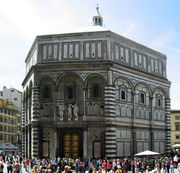
- Santa Maria del Fiore Cathedral
- The fourth largest church in Europe, its length being 153 metres (502 ft) and its height 116 metres (381 ft).
- San Giovanni Baptistery
- Located in front of the Florence Cathedral, it is decorated by many artists, notably by Lorenzo Ghiberti with the Gates of Paradise.
- Basilica of Santa Maria Novella
- Located in Santa Maria Novella square (near the big Firenze Santa Maria Novella railway station) this contains works by Masaccio, Paolo Uccello, Filippino Lippi and Domenico Ghirlandaio. The great façade was made by Leon Battista Alberti.
- Basilica of Santa Croce
- The principal Franciscan church in Florence, Italy, and a minor basilica of the Roman Catholic Church. It is situated on the Piazza di Santa Croce, about 800 metres south east of the Duomo. The site, when first chosen, was in marshland outside the city walls. It is the burial place of some of the most illustrious Italians, such as Michelangelo, Galileo, Machiavelli, Foscolo, Gentile, Rossini, and Marconi, thus it is known also as the Temple of the Italian Glories (Tempio dell'Itale Glorie).
- San Marco, Florence
- A complex comprising a church and a convent. The convent, which is now a museum, has three claims to fame: during the 15th century it was home to two famous Dominicans, the painter Fra Angelico and the preacher, Girolamo Savonarola. Also housed at the convent is a famous collection of manuscripts in a library built by Michelozzo.
- Basilica of San Lorenzo
- One of the largest churches of Florence, Italy, situated at the centre of the city's main market district, and the burial place of all the principal members of the Medici family from Cosimo il Vecchio to Cosimo III.
- Santo Spirito
- Located in the Oltrarno quarter, facing the square with the same name. The building on the interior is one of the pre-eminent examples of Renaissance architecture.
- Orsanmichele
- This building was constructed on the site of the kitchen garden of the monastery of San Michele, now gone.
- Santissima Annunziata
- A Roman Catholic basilica and the mother church of the Servite order. It is located on the north-eastern side of the Piazza Santissima Annunziata.
- Ognissanti
- Founded by the lay order of the Umiliati, this was among the first examples of Baroque architecture built in the city. Its two orders of pilasters enclose niches and windows with fantastical cornices. To the left of the façade is a campanile of thirteenth and fourteenth-century construction.
- Santa Maria del Carmine
- in the Oltrarno district of Florence, it is famous as the location of the Brancacci Chapel, housing outstanding Renaissance frescoes by Masaccio and Masolino da Panicale, later finished by Filippino Lippi.
- Santa Trinita
- It is the mother church of the Vallumbrosan Order of monks, founded in 1092 by a Florentine nobleman. Nearby is the Ponte Santa Trinita over the river Arno. The church is famous for its Sassetti Chapel, containing notable frescoes by Domenico Ghirlandaio.
- Medici Chapel in San Lorenzo
- The Medici Chapel are the resting place of most of the Medici as Grand Dukes of Tuscany. One is the Sagrestia Nuova, the "New Sacristy", designed by Michelangelo. The other is the Capella dei Principi, the 16th and 17th-century "Chapel of the Princes", which is entirely covered with a revetment of colored marbles inlaid with pietra dura.
- San Marco
- Comprises a church and a convent. The convent, which is now a museum, has three claims to fame: In the 15th century, it was home to two famous Dominicans, the painter Fra Angelico and the preacher, Girolamo Savonarola. Also housed at the convent is a famous collection of manuscripts in a library built by Michelozzo.
- Santa Felicita
- is a church in the downtown, probably the oldest in the city after San Lorenzo.
- Badia Fiorentina
- Famous as the parish church of Beatrice Portinari, the love of Dante's life, and the place where he watched her at mass, for Dante grew up across the street in what is now called the 'Casa di Dante', rebuilt in 1910 as a museum to Dante.
- San Gaetano
- One of the most important examples of the Baroque style in Florence, a city better known for its Renaissance architecture.
- San Miniato al Monte
- Standing at one of the highest points in the city, this has been described as the finest Romanesque structure in Tuscany and one of the most beautiful churches in Italy.
- Florence Charterhouse
- A charterhouse, or Carthusian monastery, located in the Florence suburb of Galluzzo, in central Italy. The building is a walled complex located on Monte Acuto, at the point of confluence of the Ema and Greve rivers.
- Great Synagogue of Florence
- A magnificent synagogue built between 1874 and 1882. The design integrates Islamic and Italian architectural traditions.
- Chiesa Russa Ortodossa della Natività
Landmarks and main sights
Museums
Proclaimed as the "art capital of Italy", Florence has immense artistic and cultural richness and contains numerous museums and art galleries where some of the world's most important works of art are held. The city is one of the best preserved Renaissance centres of art and architecture in the world and has a high concentration of art, architecture and culture.[10]
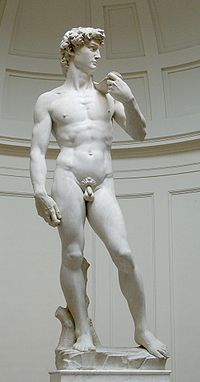
- Uffizi
- This is one of the most famous and important art galleries in the world, which contains works of art from Giotto, Cimabue, Botticelli, Leonardo da Vinci, Donatello, Michelangelo, Raphael, to name but a few.
- Vasari Corridor
- The Vasari Corridor is a gallery which connects the Palazzo Vecchio with the Pitti Palace passing by the Uffizi and over the Ponte Vecchio.
- Galleria dell' Accademia
- La Galleria dell'Accademia is famous for its Michelangelo collection, including the famous David.
- Pitti Palace
- The Florentine Palace is an important art museum, with five main art galleries:
-
- Palatine Gallery
- The Palatine Gallery, on the first floor of the piano nobile, contains a large ensemble of over 500 principally Renaissance paintings, which were once part of the Medicis' and their successors' private art collection. The gallery, which overflows into the royal apartments, contains works by Raphael, Titian, Correggio, Rubens, and Pietro da Cortona.[18] The character of the gallery is still that of a private collection, and the works of art are displayed and hung much as they would have been in the grand rooms for which they were intended rather than following a chronological sequence, or arranged according to school of art.
-
- Royal Apartments
- This is a suite of 14 rooms, formerly used by the Medici family, and lived in by their successors.[18] These rooms have been largely altered since the era of the Medici, most recently in the 19th century. They contain a collection of Medici portraits, many of them by the artist Giusto Sustermans.[19] In contrast to the great salons containing the Palatine collection, some of these rooms are much smaller and more intimate, and, while still grand and gilded, are more suited to day-to-day living requirements. Period furnishings include four-poster beds and other necessary furnishings not found elsewhere in the palazzo. The Kings of Italy last used the Palazzo Pitti in the 1920s.[20] By that time it had already been converted to a museum, but a suite of rooms (now the Gallery of Modern Art) was reserved for them when visiting Florence officially.

-
- Modern Art Gallery
- This gallery originates from the remodeling of the Florentine academy in 1748, when a gallery of modern art was established.[21] The gallery was intended to hold those art works which were prize-winners in the academy's competitions. The Palazzo Pitti was being redecorated on a grand scale at this time and the new works of art were being collected to adorn the newly decorated salons. By the mid-19th century so numerous were the Grand Ducal paintings of modern art that many were transferred to the Palazzo Croncetta, which became the first home of the newly formed "Modern Art Museum". Following the Risorgimento and the expulsion of the Grand Ducal family from the palazzo, all the Grand Ducal modern art works were brought together under one roof in the newly titled "Modern gallery of the Academy".[21] The collection continued to expand, particularly so under the patronage of Vittorio Emanuele II. However it was not until 1922 that this gallery was moved to the Palazzo Pitti where it was complemented by further modern works of art in the ownership of both the state and the municipality of Florence. The collection was housed in apartments recently vacated by members of the Italian Royal family.[22] The gallery was first opened to public viewing in 1928. Today, further enlarged and spread over 30 rooms, this large collection includes works by artists of the Macchiaioli movement and other modern Italian schools of the late 19th and early 20th centuries.[23] The pictures by the Macchiaioli artists are of particular note, as this school of 19th-century Tuscan painters led by Giovanni Fattori were early pioneers and the founders of the impressionist movement.[24] The title "gallery of modern art" to some may sound incorrect, as the art in the gallery covers the period from 1700 to early 1900. No examples of later art are included in the collection since In Italy, "modern art" refers to the period before World War II; what has followed is generally known as "contemporary art" (arte contemporanea). In Tuscany this art can be found at the Centro per l'arte contemporanea Luigi Pecci at Prato, a city about 15 km (9 mi) from Florence.
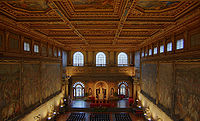
-
- Silver Museum
- Sometimes called "The Medici Treasury", this contains a collection of priceless silver, cameos, and works in semi-precious gemstones, many of the latter from the collection of Lorenzo de' Medici, including his collection of ancient vases, many with delicate silver gilt mounts added for display purposes in the 15th century. These rooms, formerly part of the private royal apartments, are decorated with 17th-century frescoes, the most splendid being by Giovanni di San Giovanni, from 1635 to 1636. The Silver Museum also contains a fine collection of German gold and silver artifacts purchased by Grand Duke Ferdinand after his return from exile in 1815, following the French occupation.[25]
-
- Costume Gallery
- Situated in a wing known as the "Palazzina della Meridiana", this gallery contains a collection of theatrical costumes dating from the 16th century until the present. It is also the only museum in Italy detailing the history of Italian fashions.[26] One of the newer collections to the palazzo, it was founded in 1983 by Kristen Aschengreen Piacenti; a suite of fourteen rooms, the Meridiana apartments, were completed in 1858.[27] In addition to theatrical costumes, the gallery displays garments worn between the 18th century and the present day. Some of the exhibits are unique to the Palazzo Pitti; these include the 16th-century funeral clothes of Grand Duke Cosimo I de' Medici, and Eleonora of Toledo and her son Garzia, both of whom died of malaria. Their bodies would have been displayed in state wearing their finest clothes, before being reclad in plainer attire before interment. The gallery also exhibits a collection of mid-20th century costume jewellery. The Sala Meridiana originally sponsored a functional solar meridian instrument, built into the fresco decoration by Anton Domenico Gabbiani.
-
- Porcelain Museum
- First opened in 1973, this museum is housed in the Casino del Cavaliere in the Boboli Gardens.[28] The porcelain is from many of the most notable European porcelain factories, with Sèvres and Meissen near Dresden being well represented. Many items in the collection were gifts to the Florentine rulers from other European sovereigns, while other works were specially commissioned by the Grand Ducal court. Of particular note are several large dinner services by the Vincennes factory, later renamed Sèvres, and a collection of small biscuit figurines.
-
- Carriages Museum
- This ground floor museum exhibits carriages and other conveyances used by the Grand Ducal court mainly in the late 18th and 19th century. The extent of the exhibition prompted one visitor in the 19th century to wonder, "In the name of all that is extraordinary, how can they find room for all these carriages and horses".[29] Some of the carriages are highly decorative, being adorned not only by gilt but by painted landscapes on their panels. Those used on the grandest occasions, such as the "Carrozza d'Oro" (golden carriage), are surmounted by gilt crowns which would have indicated the rank and station of the carriage's occupants. Other carriages on view are those used by the King of the Two Sicilies, and Archbishops and other Florentine dignitaries.
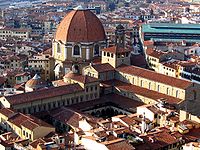
- Bargello
- This museum houses masterpieces by Michelangelo, such as his Bacchus, Pitti Tondo (or Madonna and Child), Brutus and David-Apollo.[30] Its collection includes Donatello's David and St. George Tabernacle,[31] Vincenzo Gemito's Pescatore ("fisherboy"),[32] Jacopo Sansovino's Bacco,[30] Giambologna's L’Architettura[33] and his Mercurio[30] and many works from the Della Robbia family.[31][34][35][36] Benvenuto Cellini is represented with his bronze bust of Cosimo I.[30]
- Museo dell' Opera del Duomo
This museum contains many of the original works of art and sculpture from the Florence Cathedral, including important works by Michelangelo, Donatello, Lorenzo Ghiberti, Luca and Andrea della Robbia, and others.
- Museo dell' Opificio delle Pietre Dure
- L'Opificio delle Pietre Dure, whose base is in Florence, is one of the country's most important museums, even at international levels.
- Museo di Storia Naturale
- The Museo di Storia Naturale di Firenze is a natural history museum in 6 major collections, located in Florence. It is part of the University of Florence. Museum collections are open mornings except Wednesday, and all day Saturday; an admission fee is charged. The museum was established on 21 February 1775 by Grand Duke Pietro Leopoldo as the Imperial Regio Museo di Fisica e Storia Naturale. At that time it consisted of several natural history collections housed within the palazzo Torrigiani on Via Romana. Through the past two centuries, it has grown significantly and now forms one of the finest collections in Italy.
- Institute and Museum of the History of Science
- The Institute and Museum of the History of Science (Italian: Istituto e Museo di Storia della Scienza, IMSS) is based in Florence, Italy. It was founded in 1927 by the University of Florence. The museum is located in the Palazzo Castellani, by the River Arno and close to the Uffizi Gallery. Among the more famous of its collections is the middle finger from the right hand of Galileo Galilei, which was removed when Galileo's remains were transported to a new burial spot on 12 March 1737.
- National Archaeological Museum
- The National Archaeological Museum of Florence (Italian – Museo archeologico nazionale di Firenze) is an archaeological museum in held within the city. It is located at 1 piazza Santissima Annunziata, in the Palazzo della Crocetta (a palace built in 1620 for princess Maria Maddalena de' Medici, daughter of Ferdinand I de Medici, by Giulio Parigi).
Palaces
- Palazzo Vecchio
- The town hall of Florence is also a major art museum. This massive Romanesque crenellated fortress-palace is among the most impressive town halls of Tuscany.[37]
- Palazzo Medici Riccardi
- The palace was designed by Michelozzo di Bartolomeo for Cosimo il Vecchio, of the Medici family, and was built between 1445 and 1460. It was well known for its stone masonry that includes rustication and ashlar.
- Palazzo Strozzi
- A splendid example of civil architecture with its rusticated stone, inspired by the Palazzo Medici, but with more harmonious proportions. Today the palace is used for international expositions like the annual antique show (founded as the Biennale del'Antiquariato in 1959), fashion shows and other cultural and artistic events. Here also is the seat of the Istituto Nazionale del Rinascimento and the noted Gabinetto Vieusseux, with the library and reading room.
- Palazzo Rucellai
- Designed by Leon Battista Alberti between 1446 and 1451 and executed, at least in part, by Bernardo Rossellino. Its splendid façade was one of the first to announce the new ideas of Renaissance architecture based on pilasters and entablatures in proportional relationship to each other, in a design that probably owed a great deal to Alberti's studies of Roman architecture, particularly the Colosseum, but which is also full of originality.
- Palazzo Davanzati
- Housing the museum of the Old Florentine House, this building's façade integrates a group of earlier medieval tower homes.
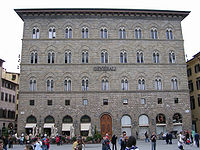
- Palazzo delle Assicurazioni Generali
- was designed in the Neo-Renaissance style in 1871, and is one of the very few purpose-built commercial buildings in the centre of the city, located in Piazza della Signoria.
- Palazzo Spini Feroni
- is a historic 13th-century private palace, owned since the 1920s by shoe-designer Salvatore Ferragamo.
- Palazzo Borghese
- one of the most beautiful and important Neoclassical palaces in the city, it is well-known for its lavish interior.
Villas, parks and arches
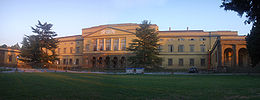
Surrounding Florence, there are numerous villas, especially built by the Medicis. There are also a fair number of parks and gardens in Florence.
- Arco di Trionfo (Triumphal Arch)
- Found in Piazza della Libertà, it is a grand arch built in the 18th century by architect Jean-Nicolas Jadot, with statues of mythological deities and heroes, inspired by the work of the Accademia.
- Arco di San Pierino
- Is a small arched-underpass between Piazza San Pier Maggiore e Via dell' Oriuolo, in one of the city's most picturesque quarters.
- Boboli Gardens
- The Boboli Gardens form a famous park in Florence, Italy, that is home to a distinguished collection of sculptures dating from the 16th to the 18th centuries, with some Roman antiquities. The gardens have passed through several stages of enlargement and restructuring work. They were enlarged in the 17th century to their present extent of 45,000 metres² (11 acres).[38]
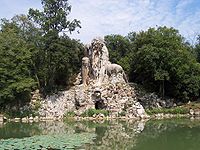
- Villa Le Balze
Le Balze is a garden villa in Fiesole, Tuscany, central Italy, very close to Florence. The villa is owned by Georgetown University and hosts year round study abroad students. Planned in 1911 by Cecil Pinsent for American Charles Augustus Strong, it was built in a tight space along the Tuscan hills overlooking the city of Florence. "Balze" is Italian for cliffs, referring to this situation.
- The Belvedere Fort
The Forte di Belvedere or Fortezza di Santa Maria in San Giorgio del Belvedere (often called simply Belvedere) is a fortification in Florence, Italy. It was built by Grand Duke Ferdinando I de' Medici during the period 1590–1595, with Bernardo Buontalenti as the designer, to protect the city and its rule by the Medici family. In particular, it was used to hold the Medici treasury. On the same side of the river as the Grand Ducal palace, the Pitti Palace in the Oltrarno district of the city, today the grounds provide spectacular outlooks over Florence; the buildings are used to hold works of art, and as a venue for exhibitions of contemporary sculpture.
- Villa Medici at Careggi
The Villa Medici at Carreggi was a patrician Florentine house. The villa was among the first[39] of a number of Medici villas, notable as the site of the Platonic academy founded by Cosimo de' Medici, who died at the villa in 1464. Like most villas of Florentine families, the villa remained a working farm that helped render the family self-sufficient. Cosimo's architect there, as elsewhere, was Michelozzo, who remodelled the fortified villa which had something of the character of a castello. Its famous garden is walled about, like a medieval garden, overlooked by the upper-storey loggias, with which Michelozzo cautiously opened up the villa's structure. Michelozzo's Villa Medici in Fiesole has a more outward-looking, Renaissance character.
- Villa di Castello
The Villa di Castello is one of the Medici villas in Florence, Tuscany, central Italy. Niccolò Tribolo was one of the architects involved in its construction.
- Villa Medici in Fiesole
The Villa Medici is a patrician villa in Fiesole, Tuscany, Italy, the fourth oldest of the villas built by the Medici family. It was built between 1451 and 1457.
- Villa La Petraia
The Villa La Petraia is one of the Medici villas in the city, built in a Renaissance style.
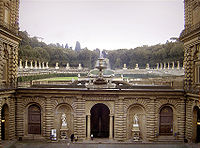
- Villa Palmieri, Fiesole
The Villa Palmieri, is a patrician villa in the picturesque town of Fiesole that overlooks Florence. The villa's gardens on slopes below the piazza S. Domenico of Fiesole are credited with being the paradisal setting for the frame story of Boccaccio's Decamerone. The villa's entrance from the town is in via Giovanni Boccaccio. The villa was certainly in existence at the end of the 14th century, when it was a possession of the Fini, who sold it in 1454 to the noted humanist scholar Marco Palmieri, whose name it still bears. In 1697, Palmiero Palmieri commenced a restructuring of the gardens, sweeping away all vestiges of the earlier garden to create a south-facing terrace, an arcaded loggia of five bays and the symmetrically paired curved stairs (a tenaglia) that lead to the lemon garden in the lower level. The often-photographed lemon garden survives,[40] though postwar renovation stripped the baroque decors from the villa's stuccoed façade.[41]
- Villa del Poggio Imperiale
Villa del Poggio Imperiale (English: Villa of the Imperial Hill) is a predominantly neoclassical former grand ducal Villa to the south of Florence in Tuscany, central Italy. From obscure beginnings, it became in succession a seized possession of the Medici, the home of a homicidal and unfaithful husband, and a lavish retreat for a Grand Duchess with imperial pretensions. Later given to Napoleon's sister, it was reclaimed by the hereditary rulers of Tuscany before being finally converted to a prestigious girls' school. During its long history, it has often been at the centre of Italy's turbulent history, and has been rebuilt and redesigned many times.
- Villa Salviatino, Maiano
The Villa Salviatino, Maiano, in the frazione of Maiano on the steep slope south of Fiesole, is a Tuscan villa overlooking Florence. A modest farmhouse in the 14th century, set among informally terraced slopes planted with vines and olives, the house in its vigna was purchased in 1427 by the Bardi family, bankers of Florence, who rebuilt it in such palatial fashion that when it was subsequently sold to Nicola Tegliacci in 1447, the new owner named it Palagio (palazzo) dei Tegliacci.[42] In the 16th century it passed to Alamanno Salviati, who had it sumptuously frescoed and furnished; thus it gained its name as the Villa Il Salviatino, to distinguish it from the grander Villa Salviati "le Selve", near Lastra, to the west.[43] The villa was celebrated by Francesco Redi, in his Bacco in Toscana (1685): "viva il nome Del buon Salviati, ed il suo bel Maiano.
- Torre del Gallo
The Torre del Gallo is located in Florence at Pian de 'Giullari, in the hills of Arcetri, on top of a ridge overlooking the city where there is a magnificent panorama. The villa, which is dominated by the tall tower, has a large hall with an octagonal vaulting, and an entry with graffiti, perhaps from the Renaissance. The court attributed to Brunelleschi is surrounded by Corinthian columns and arches on three sides, while the second neo-gothic courtyard is decorated with many coats of arms belonging to the owners of the villa and ones Bardini added.
- Villa di Quarto
The Villa di Quarto is a villa on via di Quarto in Florence, in the hilly zone at the foot of the Monte Morello. Quarto (fourth) is one of the toponyms relating to the Roman milestones, the most famous of which in this area is Sesto Fiorentino, of 45,000 inhabitants. The villa was built in the 15th century and, after various changes of ownership, in 1613 it passed to the Pasquali family, who had it rebuilt by Alfonso Parigi, designer of the Boboli extension. In the 19th century the villa took on its present appearance – it then belonged to Jérôme Bonaparte, former king of Westphalia, who left it to his daughter Mathilde Bonaparte, wife of the Russian nobleman and industrialist Anatole Demidov. It then changed hands again a few more times before being acquired in 1908 by baron Ritter de Zahony, who totally restored it. The villa's guests included the French historian and statistician Adolphe Thiers and the American writer Mark Twain – Twain's wife died here.
- Villa Feri
Villa Feri is a villa in Florence located at the corner of Via del Podestà and Via Martellini. It is known as "gentleman's villa" (villa da seniore) already in the 15th century. First known documents about this villa are dated back to 1472, when Agostino di Lotto Tanini and Agnolo di Zanobi Da Diacceto sold it to Bernardo d'Antonio degli Alberti. In 1481 becam property of the brothers Agnolo and Benedetto Bartolommei, then, at the beginiing of the 16th century, was acquired by Raffaello and Miniato Miniati. It was then property of Bartolini-Salimbeni, that modified the structure of the main building, of the Vinci family and, more lately, of the Boni family. In 1863 was finally acquired by the Feri family, which eventually gave the actual naming (the Feri family Coat of Arms is still visible on top of the main gate).
- Villa Rusciano
The Villa Rusciano is an historic villa in the neighbourhood of Florence which includes work by Brunelleschi. The villa is located at 37, Via Benedetto Fortini, Firenze. Set in a hilly area on the outskirts of Florence, the Villa has one of the most magnificent views over the city. The name is derived from the area, once a prominent agricultural estate. The villa is very old, cited by Franco Sacchetti in Trecentonovelle, and once belonged to the Salviati (bankers).
- Villa San Michele Hotel
The Villa San Michele Hotel, situated on the hill of Fiesole overlooking Florence, Italy, is named after the church of St Michael the Archangel. Today it is owned by Orient-Express Hotels and operated as a luxury hotel.
Squares
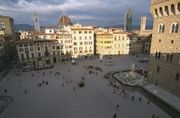
-
- Piazza del Duomo
- Piazza del Duomo is located in the heart of the historic center of Florence. Here one can find the Florence Cathedral with the Cupola del Brunelleschi, Giotto's Campanile, the Florence Baptistry, the Loggia del Bigallo, the Museo dell'Opera del Duomo, and the Arcivescovile and Canonici's palace. The west zone of this square is called San Giovanni square.
-
- Piazza della Repubblica
- Is a square in the center of Florence, location of the cultural cafes and bourgeois palaces. Among the square's cafes, the Giubbe Rosse cafe has long been a meeting place for famous artists and writers, notably those of Futurism.
-
- Piazza Santa Croce
- Dominated by the Basilica of Santa Croce it is a rectangular square in the center of the city. Here the Calcio Fiorentino is played every year and when can find on this square the Palazzo dell'Antella, the Palazzo Cocchi-Serristori (main office of center of Florence quarter) and the Dante's statue.
-
- Piazza della Signoria
- It is the focal point of the origin and of the history of the Florentine Republic and still maintains its reputation as the political hub of the city. The impressive 14th century Palazzo Vecchio is still preeminent with its crenellated tower. The square is also shared with the Loggia della Signoria, the Uffizi Gallery, the Palace of the Tribunale della Mercanzia (now the Bureau of Agriculture), and the Uguccioni Palace (16th century, with a facade by Raphael). Located in front of the Palazzo Vecchio is the Palace of the Assicurazioni Generali.
-
- Piazza San Lorenzo
- It offers the great Basilica of San Lorenzo with the Cappelle Medicee, a lively open market and the Laurentian Library.
-
- Piazza Santa Maria Novella
- With the Basilica of Santa Maria Novella and the Alinari Phography Museum, is one of the principal squares of Florence. It is opposite of Piazza della Stazione, accessible by Via degli Avelli.
-
- Piazza della Santissima Annunziata
- Located near piazza San Marco and piazza del Duomo is an harmonious square which overlook the Ospedale degli Innocenti, the Loggia dei Servi di Maria, the Budini Gattai palace and the National Archaeological Museum
-
- Piazza della Stazione
- It is a big square in the center of the city, one of the main focal point of transport in Florence. Here converge almost the entire bus-line, and tramways, and the central railway station of Florence the biggest and masterpiece of Rationalism Firenze Santa Maria Novella railway station, that is used by 59,000,000 people every year.[44] On piazza della Stazione we can also find the Palazzina Reale di Santa Maria Novella (where the king of Italy stayed), and the Palazzo degli Affari.
-
- Piazza dell' Indipendenza
- It is a wide square located near Piazza della Stazione and San Lorenzo Market, with palaces typically bourgeois where lived Guido Nobili and Theodosia Gorrow Trollope wife of the writer Anthony Trollope.
-
- Piazza San Marco
- Located in the north zone of the historic centre of Florence near Piazza della Santissima Annunziata, it hosts the Basilica of San Marco, the headquarters of the University of Florence and the renowned Academy of Fine Arts of Florence.
-
- Piazza Santa Trinita
- It is a square near the Arno that mark the end of the elegant fashion-street of Via de' Tornabuoni. On Piazza Santa Trinita overlooks the Santa Trinita church (that gives the name to the square), the Palazzo Spini Feroni, the Palazzo Buondelmonti, the Palazzo Bartolini Salimbeni and the Column of Justice.
-
- Piazza dei Ciompi
- It hosts the Loggia del Pesce made by Giorgio Vasari and the house of Lorenzo Ghiberti.
-
- Piazza d' Azeglio
- Near the viali di Circonvallazione it shows of the Villino Uzielli Palace.
-
- Piazza Goldoni
- In front of Ponte alla Carraia, in the Piazza Goldoni we can find the Palazzo Ricasoli and the statue dedicated to Carlo Goldoni.
Streets
-
- Via Camillo Cavour
- Via Camillo Cavour is one of the main roads of the northern area of the historic city centre of Florence. It was created in 1861 from two older streets, Via Larga and Via Leopoldo (as far as Piazza della Libertà, renamed Piazzale Cavour at the same time), and renamed after Camillo Cavour on 17 June 1861, just 11 days after his death.
-
- Via Ghibellina
- One of central Florence's longest streets, it leads directly towards the Bargello, and contains numerous palaces, shops and theatres.
-
- Via de' Tornabuoni
- Via de' Tornabuoni, or Via Tornabuoni, is a luxurious streets of the centre of Florence that goes from Antinori square to ponte Santa Trinita, across Piazza Santa Trinita, characterised by the presence of fashion boutiques. It contains numerous upscale fashion and jewery labels, such as Gucci, Roberto Cavalli, Salvatore Ferragamo and Bulgari, to name a few. In the past on via' de Tornabuoni was present the Casoni cocktail where the famous Negroni Café was invented in 1920 by earl Camillo Negroni. On this street there are some bars and elegant cafés, such as the well-known Gran Caffé Doney.
-
- Viali di Circonvallazione
- The Viali di Circonvallazione are a series of 6-lane boulevards surrounding the northern part of the historic centre of Florence.
-
- Via Roma
- A central street near Piazza della Repubblica, which is built in mainly 18th-19th century style architecture.
-
- Via degli Speziali
- The Via degli Speziali is an elegant street, built mainly in the 19th century neo-classical style, near Piazza della Repubblica.
Theatres and cinemas
There are numerous important historical and modern theatres in Florence. The main ones are:
-
- Odeon Cinema of the Palazzo dello Strozzino
- One of the oldest movie theatres in the city, established from 1920 to 1922[45] in a wing of the Palazzo dello Strozzino, it used to be called the Cinema Teatro Savoia (Savoy Cinema-Theatre), yet was later called Odeon. The cinema is constructed in a neo-Renaissance/Baroque style, and the arrangement of the audience seats are more like those of a normal theatre. Today, the cinema is not only a film theatre, but also a ballroom and concert-hall.
- Teatro della Pergola
- The Teatro della Pergola is an opera house in Florence, Italy. It is located in the centre of the city on the Via della Pergola. It was built in 1656 under the direction of the architect Ferdinando Tacca and its inaugural production was the opera buffa, Il podestà di Colognole by Jacopo Melani.[46] The opera house is considered to be the oldest in Italy, having occupied the same site for more than 350 years.
- Teatro Comunale di Firenze
- The Teatro Comunale di Firenze (or Teatro del Maggio Musicale Fiorentino) is an opera house in Florence. It was originally built as the open-air amphitheatre, the Politeama Fiorentiono Vittorio Emanuele which was inaugurated on 17 May 1862 with a production of Donizetti's Lucia di Lammermoor and which seated 6,000 people. It became the focus on cultural life in the city. After closure caused by fire, it reopened in April 1864 and acquired a roof in 1882. By 1911 it had both electricity and heating.
-
- Saloncino Castinelli
- A historic theatre in the centre of Florence, the Saloncino Castinelli (literally, the Castinelli small-hall) is currently a cinema.
- Teatro Puccini
- A modern theatre, opened in 1940, which specialises itself in comedies and satyrical plays.[47] There are 634 places (499 in the audience, and 135 in the gallery).
- Teatro Verdi
- Situated in central Florence, it is known for its lighter, comical plays.
- Teatro Goldoni
- The theatre was inaugurated on 17 April 1817. Nowadays, it is mainly used for dance.
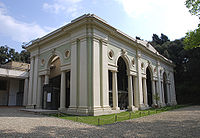
-
- Teatro Niccolini
- Also known as Teatro del Cocomero, it is found in via Ricasoli, very near to Florence Cathedral. It was frequently utlilized by Lorenzo de' Medici.
- Parco della Musica e della Cultura
- It is a vast musical complex whichi is being built in the Cascine park, and it will be a major centre of musical and theatrical culture. It will host a lyrical theatre containing 2,000 places, a concert hall for 1,000 watchers, a hall with 3,000 seats and an open-air amphitheatre with 3,000 spaces. It will host numerous ballets, concerts, lyrical operas and numerous musical festivals. The theatre will be inaugurated on 28 April 2011, in honour of the 150th anniversary of the Italian unification.[48]
Demographics
| Historical populations | ||
|---|---|---|
| Year | Pop. | %± |
| 1861 | 150,864 | — |
| 1871 | 201,138 | 33.3% |
| 1881 | 196,072 | −2.5% |
| 1901 | 236,635 | 20.7% |
| 1911 | 258,056 | 9.1% |
| 1921 | 280,133 | 8.6% |
| 1931 | 304,160 | 8.6% |
| 1936 | 321,176 | 5.6% |
| 1951 | 374,625 | 16.6% |
| 1961 | 436,516 | 16.5% |
| 1971 | 457,803 | 4.9% |
| 1981 | 448,331 | −2.1% |
| 1991 | 403,294 | −10.0% |
| 2001 | 356,118 | −11.7% |
| 2008 | 367,569 | 3.2% |
| Source: ISTAT 2001 | ||
The population of the city proper is 365,744 (30 November 2008), while Eurostat estimates that 696,767 people live in the urban area of Florence. The Metropolitan Area of Florence, Prato and Pistoia, constituted in 2000 over an area of roughly 4,800 square kilometres, is home to 1.5 million people. Within Florence proper, 46.8% of the population was male in 2007 and 53.2% were female. Minors (children aged 18 and less) totalled 14.10 percent of the population compared to pensioners, who numbered 25.95 percent. This compares with the Italian average of 18.06 percent (minors) and 19.94 percent (pensioners). The average age of Florence resident is 49 compared to the Italian average of 42. In the five years between 2002 and 2007, the population of Florence grew by 3.22 percent, while Italy as a whole grew by 3.56 percent.[49] The current birth rate of Florence is 7.66 births per 1,000 inhabitants compared to the Italian average of 9.45 births.
As of 2006, 90.45% of the population was Italian. An estimated 60,000 Chinese live in the city.[50] The largest immigrant group came from other |European countries (mostly from Albania and Romania): 3.52%, East Asia (mostly Chinese and Filipino): 2.17%, the Americas: 1.41%, and North Africa (mostly Moroccan): 0.9%.[51]
Economy
Tourism is, by far, the most important of all industries and most of the Florentine economy relies on the money generated by international arrivals and students (especially Americans) studying in the city.[52] Manufacturing and commerce, however, still remain highly important. Florence is also Italy's 17th richest city in terms of average workers' earnings, with the figure being €23,265 (the overall city's income is that of €6,531,204,473), coming after Mantua, yet surpassing Bolzano.[53]
Industry, commerce and services
Florence is a major production and commercial centre in Italy, where the Florentine industrial complexes in the suburbs produce all sorts of goods, from furntiture, rubber goods, chemicals, and food.[52] However, traditional and local products, such as antiques, handicrafts, glasswear, leatherwork, art reproductions, jewelry, souvenirs, elaborate metal and iron-work, shoes, accessories and high fashion clothes also dominate a fair sector of Florence's economy.[52] The city's income relies partially on services and commercial and cultural interests, such as annual fairs, theatrical and lyrical productions, art exhibitions, festivals and fashion shows, such as the Calcio Fiorentino. Heavy industry and machinery also take their part in provinding an income. In Nuovo Pignone, numerous factories are still present, and small-to medium industrial businesses are dominant. As a matter of fact, the Florence-Prato-Pistoia industrial districts and areas were known as the 'Third Italy' in the 1990s, due to the exports of high-quality goods and automobile (especially the Vespa) and the prosperity and productivity of the Florentine entrepreneurs. Some of these industries even rivalled the traditional industrial districts in Emilia-Romagna and Veneto due to high profits and productivity.[52]
Tourism
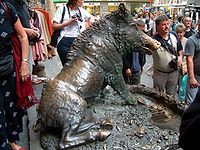
Tourism is the most significant industry in central Florence. From April to October, tourists outnumber local population. Tickets to the Uffizi and Accademia museums are regularly sold out and large groups regularly fill the basilicas of Santa Croce and Santa Maria Novella, both of which charge for entry. In 2007, readers of Travel + Leisure magazine for the third time ranked the city as their favourite tourist destination, followed in order by Bangkok, Buenos Aires, Rome, Sydney and New York City.[8] Studies by Euromonitor International have concluded that cultural and history-oriented tourism is generating significantly increased spending throughout Europe.[56]
Florence is believed to have the greatest concentration of art (in proportion to its size) in the world.[57] Thus, cultural tourism is particularly strong, with world-renowned museums such as the Uffizi selling over 1.6 million tickets[9] a year. The city's convention centre facilities were restructured during the 1990s and host exhibitions, conferences, meetings, social forums, concerts and other events all year.
Florence has approximately 35,000 hotel beds and 23,000 other accommodation facilities (campsites, guesthouses, youth hostels and farmhouses), giving potential for overall stays to exceed 10 million visitor/nights a year. Visitors also include thousands of day-trippers brought in by cruise ships (to Livorno) and by road and rail. In 2007, the city ranked as the world's 59th most visited city, with over 1.729 million arrivals for the year.[58] It has been estimated that just under one third of tourists are Italians, the remainder comprising Americans (20%), Germans (13%), Japanese (8%), Britons (7.8%), French (5.7%) and Spaniards (5%).
Food and wine production
Food and wine have long been an important staple of the economy. Florence is the most important city in Tuscany, one of the great wine-growing regions in the world. The Chianti region is just south of the city, and its Sangiovese grapes figure prominently not only in its Chianti Classico wines but also in many of the more recently developed Supertuscan blends. Within twenty miles (32 km) to the west is the Carmignano area, also home to flavorful sangiovese-based reds. The celebrated Chianti Rufina district, geographically and historically separated from the main Chianti region, is also few miles east of Florence. More recently, the Bolgheri region (about 100 miles / 200 kilometres southwest of Florence) has become celebrated for its "Super Tuscan" reds such as Sassicaia and Ornellaia.[59]
Culture
Art
.jpg)
Florence has a legendary artistic heritage. Cimabue and Giotto, the fathers of Italian painting, lived in Florence as well as Arnolfo and Andrea Pisano, renewers of architecture and sculpture; Brunelleschi, Donatello and Masaccio, forefathers of the Renaissance, Ghiberti and the Della Robbias, Filippo Lippi and Angelico; Botticelli, Paolo Uccello and the universal genius of Leonardo da Vinci and Michelangelo.[60][61]
Their works, together with those of many other generations of artists, are gathered in the several museums of the town: the Uffizi Gallery, the Palatina gallery with the paintings of the "Golden Ages",[62] the Bargello with the sculptures of the Renaissance, the museum of San Marco with Fra Angelico's works, the Academy, the chapels of the Medicis, Buonarroti' s house with the sculptures of Michelangelo, the following museums: Bardini, Horne, Stibbert, Romano, Corsini, The Gallery of Modern Art, the Museo dell'Opera del Duomo, the museum of Silverware and the museum of Precious Stones.[63]

Great monuments are the landmarks of Florentine artistic culture: the Florence Baptistery with its mosaics; the Cathedral with its sculptures, the medieval churches with bands of frescoes; public as well as private palaces: Palazzo Vecchio, Palazzo Pitti, Palazzo Medici Riccardi, Palazzo Davanzati; monasteries, cloisters, refectories; the "Certosa". In the archeological museum includes documents of Etruscan civilization.[64] In fact the city is so rich in art that some first time visitors experience the Stendhal syndrome as they encounter its art for the first time.[65]
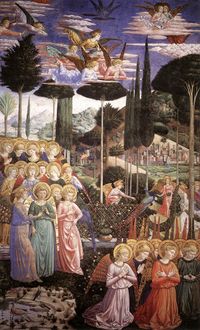
The Florentines – perhaps most notably Filippo Brunelleschi (1377–1466) and Leon Batist'Alberti (1404–1472) – invented both Renaissance and Neoclassical architecture,[66] which revolutionized the way Rome, London and Paris and every other major city in Europe – from Barcelona to St. Petersburg – were built. The cathedral – one of the largest churches, topped by Brunelleschi's dome, dominates the Florentine skyline. The Florentines decided to start building it – late in the 13th century – knowing they did not know how they were going to do it. It was "technology forcing" – like the Kennedy Administration's decision to put a man on the moon. The dome was the largest ever built at the time, and the first major dome built in Europe since the two great domes of Roman times – the Pantheon in Rome, and Hagia Sophia in Constantinople. As a matter of fact, as mentioned in sections above, the Santa Maria del Fiore dome remains the largest brick dome of its kind in the world.[67][68] In front of it is the medieval gem of the Baptistery, where every Florentine was baptized until modern times. The two buildings incorporate in their decoration the transition from the Middle Ages to the Renaissance. In recent years, most of the important works of art from the two buildings – and from the wonderful Bell Tower, designed by Giotto, have been removed and replaced by copies. The originals are now housed in the spectacular Museum of the Works of the Duomo, just to the east of the Cathedral.
Florence has large numbers of art-filled churches,[11] such as San Miniato al Monte, San Lorenzo, Santa Maria Novella, Santa Trinita, the Brancacci Chapel at Santa Maria della Carmine, Santa Croce, Santo Spirito, SS Annunziata, Ognissanti and many more.
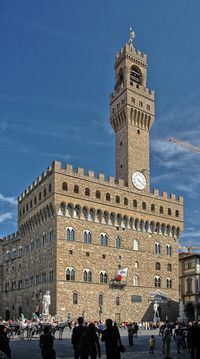
And that is without mentioning any "artists". From Arnolfo and Cimabue to Giotto, Nanni di Banco, and Uccello; through Lorenzo Ghiberti, and Donatello and Massaccio and the various della Robbias; through Fra Angelico and Botticelli and Piero della Francesca, and on to Michelangelo and Leonardo da Vinci, the Florentines have dominated the visual arts in a great way. And this list does not include many who, in any other place would be considered among the greatest of artists, but in Florence must be considered among the near-great: Benvenuto Cellini, Andrea del Sarto, Benozzo Gozzoli, Domenico Ghirlandaio, Fra Lippo Lippi, Buontalenti, Orcagna, Pollaiuolo, Filippino Lippi, Verrocchio, Bronzino, Desiderio da Settignano, Michelozzo, the Rossellis, the Sangallos, Pontormo, just to name a few. And this list does not include the prolific Ignoto. Nor does it include the near-Florentines, such as Raphael, Andrea Pisano, Giambologna, the wonderfully nicknamed Sodoma and so many more, such as Peter-Paul Rubens — all of whom spent time in Florence and were nurtured by it.
Then there are the art galleries. The Uffizi and the Pitti Palace are two of the most famous picture galleries in the world.[69] But the heart and soul of Florence are in the two superb collections of sculpture, the Bargello and the Museum of the Works of the Duomo. They are filled with the brilliant, revolutionary creations of Donatello, Verrochio, Desiderio da Settignano, Michelangelo and so many other masterpieces that create a body of work unique in the world. And, of course, there is the Accademia, with Michelangelo's David – perhaps the most well-known work of art anywhere, plus the moving unfinished statues of the slaves Michelangelo created for the tomb of Pope Julius II.
In all, Florence has a great and numerous amount of museums.[70][71] Among those at the top of most lists – other than those above – are: the impressive medieval city hall, the Palazzo della Signoria (a.k.a Palazzo Vecchio), a wonderful building with magnificent rooms and some great art; the Archeological Museum, the Museum of the History of Science, the Palazzo Davanzatti, the Stibbert Museum, St. Marks, the Medici Chapels, the Museum of the Works of Santa Croce, the Museum of the Cloister of Santa Maria Novella, the Zoological Museum ("La Specola"), the Bardini, and the Museo Horne. There is also a wonderful collection of works by the modern sculptor, Marino Marini, in a museum named after him. If photography is your interest, you should not miss the superb collection of works by the early photographers, the Alinari brothers. The magnificent Strozzi Palace is also the site of many special exhibits.[72]
Language
Florentine (fiorentino), spoken by inhabitants of Florence and its environs, is a Tuscan dialect and an immediate parent language to modern Italian. (Many linguists and scholars of Dante, Boccaccio, and Petrarch consider standard Italian to be, in fact, modern Florentine.)
Its vocabulary and pronunciation are largely identical to standard Italian, though the hard c [k] between two vowels (as in ducato) is pronounced as a fricative [h], similar to an English h. This gives Florentines a distinctive and highly recognizable accent (the so-called gorgia toscana). Other traits include using a form of the subjunctive mood last commonly used in medieval times, a frequent usage in everyday speech of the modern subjunctive, and a shortened pronunciation of the definite article, [i] instead of "il".
Dante, Petrarch, and Boccaccio pioneered the use of the vernacular[73] – the use of a language other than Latin, in their case, Tuscan, which, because of them, became Italian. Because Dante, et al., wrote in Tuscan, Geoffrey Chaucer – who spent a lot of time in Northern Italy and who stole Boccaccio's little stories – wrote in English. And others started writing in French and Spanish and so on. This was the beginning of the end of Latin as a common language throughout Europe.
Literature
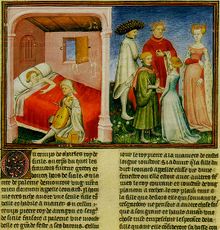
Home to some of the greatest literary figures in history, Florence sports a long and eventful history regarding this subject. Despite Latin being the main language of the courts and the Church, writers such as Dante Alighieri, (born in 1265, died 1321),[73] and many more, as mentioned above, used their own language, the Florentine dialect, in composing their works. The oldest literary pieces written in vernacular language go as far back as the 13th century. Florence's literature fully blossomed in the 14th century, when not only Dante with is Divine Comedy (1306–1321) and Petrarch, but also poets such as Guido Cavalcanti and Lapo Gianni, to name but a few, composed their most important works.[73] Dante's masterpiece the Divine Comedy mainly deals with the poet himself taking a tour of Hell, Purgatory and finally Heaven. He is first guided by the Roman poet Virgil, whose non-Christian beliefs damned him to Hell. Later on he's joined by Beatrice who guides him through Heaven.[73]
Francesco Petrarca (Petrarch) was born in 1304, and died in 1374.[74] Giovanni Boccaccio,[74] was born in 1313 and died in 1375.[73] They led the literary scene in Florence after Dante's death in 1321. Petrarch was an all-rounder writer, author and poet, but was particularly known for his book the Canzoniere, or the Book of Songs, where he conveyed his unremitting love for Laura.[74] His style of writing has since become known as Petrarchism.[74] Giovanni Boccaccio was better known for his classic the Decameron, a slightly grim story of Florence during the 1350s bubonic plague, known as the Black Death, when some people fled the ravaged city to an isolated country mansion, and spent their time there recounting stories about themselves. All of this is written in a series of 100 distinct novellas.[74]
In the 16th century, during the Renaissance, Florence was the hometown of political writer and philosopher Nicolò Machiavelli, whose ideas on how rulers should govern the land, detailed in The Prince, spread across European courts and enjoyed enduring popularity for centuries. These principles became known as Machiavellianism.
Music
Florence became a significant musical centre during the Middle Ages and music and the performing arts remain an important part of its culture. During the Renaissance there were four kinds of musical patronage in the city with respect to both sacred and secular music: state, corporate, church, and private.[75] and it was here that the Florentine Camerata convened in the mid-16th century and experimented with setting tales of Greek mythology to music and staging the result—in other words, the first operas, setting the wheels in motion not just for the further development of the operatic form, but for later developments of separate "classical" forms such as the symphony.
Opera was invented in Florence in the late 16th century.[76]
Composers and musicians who have lived in Florence include Piero Strozzi (1550 – after 1608), Giulio Caccini (1551–1618) and Mike Francis (1961–2009).
Cinema
Florence has been a setting for numerous works of fiction and movies, including the novels and associated films, such as Calmi Cuori Appassionati, Hannibal, A Room with a View, Tea with Mussolini and Virgin Territory. The city is also home to numerous renowned Italian actors and actresses, such as Roberto Benigni, Leonardo Pieraccioni and Vittoria Puccini.
Cuisine
Florentine food grows out of a tradition of peasant eating rather than rarefied high cooking. The vast majority of dishes are based on meat. The whole animal was traditionally eaten; various kinds of tripe, (trippa) and (lampredotto) were once regularly on the menu and still are sold at the remaining food carts stationed throughout the city. Antipasti include crostini toscani, sliced bread rounds topped with a chicken liver-based pâté, and sliced meats (mainly prosciutto and salami, often served with melon when in season). The typically saltless Tuscan bread, obtained with natural levain frequently features in Florentine courses, especially in its famous soups, ribollita and pappa al pomodoro, or in the salad of bread and fresh vegetables called panzanella that is served in summer. The most famous main course is the bistecca alla fiorentina, a large (the customary size should weigh around 1200 grams – "40 oz.") – the "date" steak – T-bone steak of Chianina beef cooked over hot charcoal and served very rare with its more recently derived version, the tagliata, sliced rare beef served on a bed of arugula, often with slices of Parmesan cheese on top. Most of these courses are generally served with local olive oil, also a prime product enjoying a worldwide reputation.[77]
Research activity
Many research institutes and University Departments are located within the Florence area and within two campus recently developed at Polo di Novoli and Polo Scientifico di Sesto Fiorentino[78] as well as in the Research Area of Consiglio Nazionale delle Ricerche.[79]
Science and discovery
Florence has been an important scientific centre for centuries, notably during the Renaissance, where there was a great period of discovery and innovation, with scientists such as Leonardo da Vinci.
Florentines were one of the driving forces behind the Age of Discovery. Florentine bankers financed Henry the Navigator and the Portuguese explorers who pioneered the route around Africa to India and the Far East. It was a map drawn by the Florentine Paulo del Pozzo Toscanelli, a student of Brunelleschi, that Columbus used to sell his "enterprise" to the Spanish monarchs, and which he used on his first voyage. Mercator's famous "Projection" is a refined version of Toscanelli's – taking into account the Americas, of which the Florentine was, obviously, ignorant. The western hemisphere, itself, is named after a Florentine explorer and mapmaker, Amerigo Vespucci.
Gallileo and other scientists pioneered the study of optics, ballistics, astronomy, anatomy, and so on. Pico della Mirandola, Leonardo Bruni, Machiavelli, and many others laid the groundwork for our understanding of political science.
Fashion
Florence being historically the first home of Italian fashion (the 1951–1953 soirées held by Giovanni Battista Giorgini are generally regarded as the birth of the Italian school[80] as opposed to French haute couture) is also home to the legendary Italian fashion establishment Salvatore Ferragamo, notable as one of the oldest and most famous Italian fashion houses. Many others, most of them now located in Milan, were founded in Florence. Gucci, Prada, Roberto Cavalli, and Chanel have large offices and stores in Florence or its outskirts. Florence's main upscale shopping street is Via de' Tornabuoni, where major luxury fashion houses and jewelry labels, such as Armani, Ferragamo and Bulgari, have their elegant boutiques.
There are also a few places to buy things, from the high-end jewelry stores lining the Ponte Vecchio to some of the most famous shops in the world – Gucci, Pucci, Ferragamo, Valentino, Prada, Armani, Ermenegildo Zegna, Buccellati, Frette, etc., as well as several less-well known or more recent minor fashion boutiques. It is increasingly difficult to find bargains, but keen-eyed shoppers can still find good deals on smaller, side streets running off of those above and elsewhere in the center of town. The San Lorenzo market is now largely for tourists. There are also a couple of collections of "outlets" in the suburbs. Great places to walk include along the Arno and across any of its bridges, through narrow, medieval back streets in the Santa Croce area and in the Oltr'Arno – on the south side of the river, in many ways like Rome's Trastevere or Paris's Left Bank – but far, far smaller. There are also superb shopping streets, such as the Via Tornabuoni, the Via del Parione, and the Via Maggio.
Historical evocations
Scoppio del Carro
The Scoppio del Carro ("Explosion of the Cart") is a celebration of the First Crusade. During the day of Easter, a cart, which the Florentines call the Brindellone and which is led by four white oxen, is taken to the Piazza del Duomo between the Baptistery of St. John the Baptist (Battistero di San Giovanni) and the Florence Cathedral (Santa Maria del Fiore). The cart is connected by a rope to the interior of the church. Near the cart there is a model of a dove which, according to legend, is a symbol of good luck for the city: at the end of the Easter mass, the dove emerges from the nave of the Duomo and ignites the fireworks on the cart.
Calcio Storico
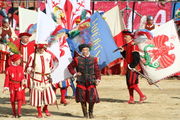
Calcio Storico Fiorentino ("Historic Florentine Football"), sometimes called Calcio in costume, is a traditional sport, regarded as a forerunner of soccer, though the actual gameplay most closely resembles rugby. The event originates from the Middle Ages, when the most important Florentine nobles amused themselves playing while wearing magnificent costumes. The most important match was played on 17 February 1530, during the siege of Florence. That day Papal troops besiged the city while the Florentines, with contempt of the enemies, decided to play the game notwithstanding the situation. The game is played in the Piazza di Santa Croce. A temporary arena is constructed, with bleachers and a sand-covered playing field. A series of matches are held between four teams representing each quartiere (quarter) of Florence during late June and early July.[81] There are four teams: Azzurri (light blue), Bianchi (white), Rossi (red) and Verdi (green). The Azzurri are from the quarter of Santa Croce, Bianchi from the quarter of Santo Spirito, Verdi are from San Giovanni and Rossi from Santa Maria Novella.
Traditions
The Third Countship of Florence
The four counts and four countesses of Florence have a large but hidden tradition dating back to the early 20th century when a favoured Tuscan family left the city to Malta and the youngest daughter of the family was declared Contessa Morabitto di Florenze Countess Morabitto of Florence. To the present date there are eight members of the countship, six living in Malta, one in England and one living in Italy.
Transport
The principal public transport network within the city is run by the ATAF and Li-nea bus company, with tickets available at local tobacconists, bars and newspaper stalls. Individual tickets or a pass called the Carta Agile with multiple rides (10 or 21) may be used on buses. Once on the bus, tickets must be stamped (or swiped for the Carta Agile) using the machines on board unlike the train tickets which must be validated before boarding. The main bus station is next to Santa Maria Novella railway station. Trenitalia runs trains between the railway stations within the city, and to other destinations around Italy and Europe. The central railway station, Santa Maria Novella railway station, is located about 500 metres (1,600 ft) northwest of the Piazza del Duomo. There are two other important stations: Campo Di Marte and Rifredi. Most bundled routes are Firenze-Pisa, Firenze-Viareggio and Firenze-Arezzo (along the main line to Rome). Other local railways connect Florence with Borgo San Lorenzo and Siena.
Long distance buses are run by the SITA, Copit, CAP and Lazzi companies. The transit companies also accommodate travellers from the Amerigo Vespucci Airport, which is five kilometres (3.1 mi) west of the city centre, and which has scheduled services run by major European carriers such as Air France and Lufthansa.
The centre of the city is closed to through-traffic, although buses, taxis and residents with appropriate permits are allowed in. This area is commonly referred to the ZTL (Zona Traffico Limitato), which is divided into five subsections. Residents of one section, therefore, will only be able to drive in their district and perhaps some surrounding ones. Cars without permits are allowed to enter after 7.30pm, or before 7.30am in the morning. The rules shift somewhat unpredictably during the tourist-filled summers, putting more restrictions on where one can get in and out.
Due to the high level of air pollution and traffic in the city, an urban tram network called the TramVia is currently under construction in the city.[82] The first line runs from Scandicci to the southwest through the western side of the city, cross the River Arno at the Cascine Park and arrive to the main railway station of Santa Maria Novella. Two other lines are in the final design phase.
Railway station
- Firenze Santa Maria Novella railway station
- is the main national and international railway station in Florence and is used by 59.000.000 people every year.[83]
- Firenze Rifredi railway station
- Firenze Campo di Marte railway station
- Firenze Belfiore railway station
- Firenze Cascine railway station
- Firenze Castello railway station
- Firenze Rovezzano railway station
- Firenze San Marco Vecchio railway station
- Firenze Statuto railway station
- Firenze Porta al Prato railway station
- Firenze Le Cure railway station
- Firenze Le Piagge railway station
- Firenze Salviati railway station
- Firenze Piazza Puccini Station
Airport
Florence's Peretola Airport is one of two main airports in the Tuscany region, the other being Galileo Galilei International Airport in Pisa.
Sport
Florence is represented by ACF Fiorentina, who plays in Serie A, the top league of Italian football. They play their games at the Stadio Artemio Franchi. The city is also home of Coverciano, the main training ground of the Italian national team, and the technical department of the Italian Football Federation.
Administration
The current Mayor of Florence is Matteo Renzi (Democratic Party, elected in June 2009).[84]
International relations
Twin towns—Sister cities
Florence is twinned with:
Partnerships
Notable residents
- Sir Harold Acton, author and aesthete.
- Leone Battista Alberti, polymath.
- Dante Alighieri, poet.
- Giovanni Boccaccio, poet.
- Sandro Botticelli, painter.
- Aureliano Brandolini, agronomist and development cooperation scholar.
- Robert Browning and Elizabeth Barrett Browning, 19th century English poets.
- Filippo Brunelleschi, architect.
- Michelangelo Buonarroti, sculptor, painter, also famous for the ceiling of the Sistine Chapel and David.
- Roberto Cavalli, fashion designer.
- Enrico Coveri, fashion designer.
- Virginia Oldoini, Countess of Castiglione. Early photographic artist, Secret agent and Courtesan.
- Leonardo da Vinci, polymath, famous for paintings, inventions, and scientific experiments.
- Giotto di Bondone, early 14th century painter, sculptor and architect.
- Donatello, sculptor.
- Oriana Fallaci, journalist and author.
- Salvatore Ferragamo, fashion designer and "shoemaker to the stars".
- Frescobaldi Family, notable bankers and wine producers.
- Galileo Galilei, Italian physicist, astronomer, and philosopher.
- Lorenzo Ghiberti, sculptor.
- Guccio Gucci, founder of the Gucci label.
- Robert Lowell, poet.
- Niccolò Machiavelli, poet, philosopher and political thinker, author of The Prince and The Discourses.
- Masaccio, painter.
- Medici family.
- Antonio Meucci, inventor of the telephone.
- Florence Nightingale, pioneer of modern nursing, and a noted statistician.
- Mike Francis (musician) born Francesco Puccioni, singer and composer
- Raphael, painter.
- Girolamo Savonarola
- Giorgio Vasari, painter, architect, and historian.
- Amerigo Vespucci, explorer and cartographer, namesake of the Americas.
- Rose McGowan, American actress who was born in Florence.
See also
- Buildings and structures in Florence
- Chancellor of Florence
- Florentine School
- Guilds of Florence
- Historical states of Italy
- List of Florentine churches
- Stendhal syndrome
- University of Florence
- European University Institute
- Fashion designers of Florence
- Squares of Florence
References
As of this edit, this article uses content from "Florence", which is licensed in a way that permits reuse under the Creative Commons Attribution-ShareAlike 3.0 Unported License, but not under the GFDL. All relevant terms must be followed.
Bibliography
- Brucker, Gene A. (1983). Renaissance Florence.
- Brucker, Gene A. (1971). The Society of Renaissance Florence: A Documentary Study.
- Chamberlin, Russell (22 May 2008). Travellers Florence & Tuscany, 3rd: Guides to Destinations Worldwide. Thomas Cook Publishing. ISBN 9781841578446. http://books.google.com/books?id=sdekGAAACAAJ. Retrieved 11 March 2010.
- Chaney, Edward(2003), A Traveller's Companion to Florence.
- Goldthwaite, Richard A. (1982). The Building of Renaissance Florence: An Economic and Social History.
- Hibbert, Christopher (1999). The House of Medici: Its Rise and Fall.
- Lewis, R.W.B. (1996). The City of Florence: Historical Vistas and Personal Sightings.
- Najemy, John (2006). A History of Florence 1200–1575.
- Schevill, Ferdinand (1936). History of Florence: From the Founding of the City Through the Renaissance.
- Trexler, Richard C. (1991). Public Life in Renaissance Florence.
- Ferdinand Schevill, History of Florence: From the Founding of the City Through the Renaissance (Frederick Ungar, 1936) is the standard overall history of Florence.
Primary sources
- Niccolò Machiavelli. Florentine Histories numerous editions
Notes
- ↑ ‘City’ population (i.e., that of the comune or municipality) from demographic balance: January–April 2009, ISTAT.
- ↑ Bilancio demografico anno 2008, dati ISTAT
- ↑ "Economy of Renaissance Florence, Richard A. Goldthwaite, Book – Barnes & Noble". Search.barnesandnoble.com. 23 April 2009. http://search.barnesandnoble.com/Economy-of-Renaissance-Florence/Richard-A-Goldthwaite/e/9780801889820. Retrieved 22 January 2010.
- ↑ Profs. Spencer Baynes, L.L.D., and W. Robertson Smith, L.L.D., Encyclopædia Britannica. Akron, Ohio: The Werner Company, 1907: p.675
- ↑ "Florence – one of the most beautiful cities in the world". Intstudy.com. http://www.intstudy.com/articles/florence.htm. Retrieved 22 January 2010.
- ↑ "About Florence, your tourist guide to Florence, Italy". Aboutflorence.com. http://www.aboutflorence.com/. Retrieved 22 January 2010.
- ↑ "Renaissance – Focus on Florence". Learner.org. http://www.learner.org/interactives/renaissance/florence_sub2.html. Retrieved 22 January 2010.
- ↑ 8.0 8.1 "Travel + Leisure". Travelandleisure.com. http://www.travelandleisure.com/worldsbest/2007/results.cfm?cat=cities. Retrieved 14 March 2010.
- ↑ 9.0 9.1 "Contact Support". Itvnews.tv. http://www.itvnews.tv/Blog/Blog/the-50-most-visited-places.html. Retrieved 22 January 2010.
- ↑ 10.0 10.1 Miner, Jennifer (2 September 2008). "Florence Art Tours, Florence Museums, Florence Architecture". Travelguide.affordabletours.com. http://travelguide.affordabletours.com/search/Article/guide/19/. Retrieved 22 January 2010.
- ↑ 11.0 11.1 "Florence (Italy)". Britannica Concise Encyclopedia. Britannica.com. http://www.britannica.com/EBchecked/topic/210642/Florence. Retrieved 14 March 2010.
- ↑ http://italian.about.com/library/weekly/aa060699a.htm
- ↑ "Plague". Brown.edu.
- ↑ http://koeppen-geiger.vu-wien.ac.at/pics/kottek_et_al_2006.gif
- ↑ MeteoAM.it! Il portale Italiano della Meteorologia (20 May 2005). "MeteoAM.it! Il portale Italiano della Meteorologia". Meteoam.it. http://www.meteoam.it/modules.php?name=elementiClima. Retrieved 22 January 2010.
- ↑ "World Weather Information Service - Florence". http://worldweather.wmo.int/176/c00602.htm. Retrieved 2010-04-14.
- ↑ Ross King,Brunelleschi's Dome, The Story of the great Cathedral of Florence, Penguin, 2001
- ↑ 18.0 18.1 Polo Museale Fiorentino (2007). "The Palatine Gallery and Royal Apartments". Polo Museale Fiorentino. Ministero per i Beni e le Attivit Culturali. http://www.polomuseale.firenze.it/english/musei/palatina/default.asp. Retrieved 8 January 2008.
- ↑ Perlove, Shelley. "An Unpublished Medici Gamepiece by Justus Sustermans". The Burlington Magazine; 131, 1035, 1989. pp. 411–414
- ↑ Levey, p. 416.
- ↑ 21.0 21.1 Chiarini, p. 77
- ↑ Chiarini, p. 78
- ↑ Polo Museale Fiorentino (2007). "The Gallery of Modern Art". Polo Museale Fiorentino. Ministero per i Beni e le Attivit Culturali. http://www.polomuseale.firenze.it/english/musei/artemoderna/default.asp. Retrieved 8 January 2008.
- ↑ Broude, Norma (1987). The Macchiaioli: Italian Painters of the Nineteenth Century. New Haven and London: Yale University Press. ISBN 0-300-03547-0
- ↑ Polo Museale Fiorentino (2007). "The "museo degli Argenti" (The Medici Treasury)". Polo Museale Fiorentino. Ministero per i Beni e le Attivit Culturali. http://www.polomuseale.firenze.it/english/musei/argenti/default.asp. Retrieved 8 January 2008.
- ↑ Polo Museale Fiorentino (2007). "The Costume Gallery". Polo Museale Fiorentino. Ministero per i Beni e le Attivit Culturali. http://www.polomuseale.firenze.it/english/musei/costume/default.asp. Retrieved 8 January 2008.
- ↑ Arnold, Janet (June 1984). "Review: Costumes at Palazzo Pitti. Florence". The Burlington Magazine 126 (975): 371 + 378. http://links.jstor.org/sici?sici=0007-6287(198406)126%3A975%3C371%3ACAPPF%3E2.0.CO%3B2-A. Retrieved 12 January 2008.
- ↑ Polo Museale Fiorentino (2007). "The Porcelain museum". Polo Museale Fiorentino. Ministero per i Beni e le Attivit Culturali. http://www.polomuseale.firenze.it/english/musei/porcellane/default.asp. Retrieved 8 January 2008.
- ↑ "The Parterre of fiction, poetry, history [&c.]". Oxford University, 1836. p. 144.
- ↑ 30.0 30.1 30.2 30.3 "Sala di Michelangelo e della scultura del Cinquecento". Bargello National Museum. Ministry of Cultural Heritage. http://www.polomuseale.firenze.it/english/musei/bargello/opere.asp?s=99. Retrieved 24 July 2006.
- ↑ 31.0 31.1 "Salone di Donatello e della Scultura del Quattrocento". Bargello National Museum. Ministry of Cultural Heritage. http://www.polomuseale.firenze.it/english/musei/bargello/opere.asp?s=104. Retrieved 24 July 2006.
- ↑ "Il Cortile". Bargello National Museum. Ministry of Cultural Heritage. http://www.polomuseale.firenze.it/english/musei/bargello/opere.asp?s=97. Retrieved 24 July 2006.
- ↑ "Verone". Bargello National Museum. Ministry of Cultural Heritage. http://www.polomuseale.firenze.it/english/musei/bargello/opere.asp?s=105. Retrieved 24 July 2006.
- ↑ "Cappella di Maria Maddalena e Sagrestia". Bargello National Museum. Ministry of Cultural Heritage. http://www.polomuseale.firenze.it/english/musei/bargello/opere.asp?s=101. Retrieved 24 July 2006.
- ↑ "Sala di Giovanni della Robbia". Bargello National Museum. Ministry of Cultural Heritage. http://www.polomuseale.firenze.it/english/musei/bargello/giovanni_robbia.asp. Retrieved 24 July 2006.
- ↑ "Sala di Andrea della Robbia". Bargello National Museum. Ministry of Cultural Heritage. http://www.polomuseale.firenze.it/english/musei/bargello/andrea_robbia.asp. Retrieved 24 July 2006.
- ↑ Style is referred to as Gothic
- ↑ Zucconi, Guido (1995). Florence: An Architectural Guide (2001 Reprint ed.). San Giovanni Lupatoto (Vr): Arsenale Editrice. ISBN.
- ↑ The Villa Medicea di Cafaggiolo and the Villa Medicea del Trebbio in the valley of the Mugello had been previous purchases.
- ↑ Illustrated, for example, in Georgina Masson, Otalian Gaddeens fig. 46, p. 98.
- ↑ The terracotta bust of Matteo Palmieri by Antonio Rossellino (1468) once in an exterior niche of the villa is now in the Museo Nazionale del Bargello, Florence.
- ↑ Il Salviatino: History
- ↑ Touring Club Italiano, Firenze e dintorni (Milan, 1964) p. 406f; Eclettismo a Firenze. L'attività di Corinto Corinti', (Florence, 1985); G. Carocci I dintorni di Firenze (Florence, 1906); Lensi Orlandi Cardini, Le ville di Firenze (Florence, 1954).
- ↑ Le stazioni più grandi d'Italia
- ↑ "Gruppo Cine Hall". Cinehall.it. http://www.cinehall.it/pagine/odeon.asp. Retrieved 2010-05-19.
- ↑ Great Opera Houses by Spike Hughes London 1956
- ↑ "// Teatro Puccini //". Teatropuccini.it. http://www.teatropuccini.it/. Retrieved 2010-05-19.
- ↑ Filippo. "UrbanFile – Firenze | Nuovo Auditorium Nel Parco Della Musica E Della Cultura". Urbanfile.it. http://www.urbanfile.it/index.asp?ID=3&SID=230. Retrieved 22 January 2010.
- ↑ "Statistiche demografiche ISTAT". Demo.istat.it. http://demo.istat.it/bil2007/index.html. Retrieved 5 May 2009.
- ↑ Chinese immigrants to Italy build no ordinary Chinatown, Chicago Tribune, 1 January 2009
- ↑ "Statistiche demografiche ISTAT". Demo.istat.it. http://demo.istat.it/str2006/index.html. Retrieved 5 May 2009.
- ↑ 52.0 52.1 52.2 52.3 "Florence (Italy)". Britannica Concise Encyclopedia. Britannica.com. http://www.britannica.com/EBchecked/topic/210642/Florence#. Retrieved 22 January 2010.
- ↑ "La classifica dei redditi nei comuni capoluogo di provincia". Il Sole 24 ORE. http://www.ilsole24ore.com/speciali/redditi_comuni_08/. Retrieved 2010-05-19.
- ↑ "Four Seasons Hotel, Firenze in Florence | Food & Wine". Foodandwine.com. http://www.foodandwine.com/hotels/four-seasons-hotel-firenze. Retrieved 2010-05-19.
- ↑ "Four Seasons Hotel Florence, Florence, Italy in the Condé Nast Traveler Gold List on". Concierge.com. http://www.concierge.com/tools/travelawards/goldlist/2010/hotels/501737?lastUrl=/tools/travelawards/goldlist/2010/category/rooms. Retrieved 2010-05-19.
- ↑ Tourists spend more than ever before on cultural destinations (for 2004–2005) at Euromonitor International
- ↑ "Study Abroad in Florence Italy – Florentine artisan courses for school groups". Florenceart.net. http://florenceart.net/studyabroad/. Retrieved 22 January 2010.
- ↑ "Euromonitor International's Top City Destinations Ranking". Euromonitor.com. 12 December 2008. http://www.euromonitor.com/_Euromonitor_Internationals_Top_City_Destinations_Ranking. Retrieved 21 March 2010.
- ↑ winepros.com.au. Oxford Companion to Wine. "Bolgheri". http://www.winepros.com.au/jsp/cda/reference/oxford_entry.jsp?entry_id=369.
- ↑ Art in Florence http://www.learner.org/interactives/renaissance/florence_sub2.html
- ↑ Renaissance Artists http://library.thinkquest.org/2838/artgal.htm
- ↑ "Uffizi Gallery Florence • Uffizi Museum • Ticket Reservation". Virtualuffizi.com. http://www.virtualuffizi.com/uffizi/. Retrieved 5 May 2009.
- ↑ "Palace of Bargello ( Bargello's Palace ), Florence Italy – ItalyGuides.it". ItalyGuides.it. 28 October 2006. http://www.italyguides.it/us/florence/palace_of_bargello.htm. Retrieved 5 May 2009.
- ↑ "Inner court of Pitti Palace (Palazzo Pitti), Florence Italy – ItalyGuides.it". ItalyGuides.it. 28 October 2006. http://www.italyguides.it/us/florence/pitti_palace.htm. Retrieved 5 May 2009.
- ↑ Auxologia: Graziella Magherini: La Sindrome di Stendhal (book) (excerpts in Italian)
- ↑ "Why Was Florence Considered Important For Culture And Arts? – Essay – Michellekim". Oppapers.com. http://www.oppapers.com/essays/Why-Florence-Considered-Important-Culture-Arts/74009. Retrieved 14 March 2010.
- ↑ "The Duomo of Florence | Tripleman". www.tripleman.com. http://www.tripleman.com/index.php?showimage=737. Retrieved 25 March 2010.
- ↑ "brunelleschi's dome – Brunelleschi's Dome". Brunelleschisdome.com. http://www.brunelleschisdome.com/. Retrieved 25 March 2010.
- ↑ "The Uffizi Gallery (Galleria degli Uffizi), Florence Italy". ItalyGuides.it. 28 October 2006. http://www.italyguides.it/us/florence/uffizi_gallery.htm. Retrieved 14 March 2010.
- ↑ "Florence, Tuscany Region, Italy – The Duomo, Statue Of David, Piazza Dell Signoria". Europe.travelonline.com. http://www.europe.travelonline.com/italy/region_florence.html. Retrieved 25 March 2010.
- ↑ "Florence Art Gallery: Art Galleries and Museums in Florence Area, Italy". Florence.world-guides.com. http://www.florence.world-guides.com/art_galleries.html. Retrieved 25 March 2010.
- ↑ "Become a friend of Palazzo Strozzi – Fondazione Palazzo Strozzi – Firenze". Palazzostrozzi.org. http://www.palazzostrozzi.org/Sezione.jsp?idSezione=181. Retrieved 25 March 2010.
- ↑ 73.0 73.1 73.2 73.3 73.4 "Literature in Florence, Florentine Writers and Poets". Florenceholidays.com. http://www.florenceholidays.com/florence-vacation-literature-in-florence.html. Retrieved 25 March 2010.
- ↑ 74.0 74.1 74.2 74.3 74.4 "Literature in Florence – Petrarch and Boccaccio, Florentine Writers and Poet: Petrarch and Boccaccio". Florenceholidays.com. http://www.florenceholidays.com/florence-vacation-literature-in-florence-petrarch-boccaccio.html. Retrieved 25 March 2010.
- ↑ ‘Frank D'Accone, Lorenzo il Magnifico and Music’, in Lorenzo il Magnifico e il suo mondo. Convegno Internazionale di Studi, Firenze, 9–13 giugno 1992, edited by Gian Carlo Garfagnini, 259–290, Istituto Nazionale di Studi sul Rinascimento. Atti di Convegni, XIX (Florence: Olschki, 1994), 260.
- ↑ http://sfopera.com/images/education/History_Opera(3).pdf
- ↑ welcometuscany.it. "tuscany italy tuscany tourists guide, travel tips extra virgin olive oil wines and foods of the most beautiful land in the world". Welcometuscany.it. http://www.welcometuscany.it/special_interest/wine_food_olive_oil/olive_oil.htm. Retrieved 5 May 2009.
- ↑ "Polo Scientifico di Sesto Fiorentino". http://www.polosci.unifi.it/mdswitch.html.
- ↑ "Florence CNR Research Area". http://www.area.fi.cnr.it/english/.
- ↑ "the birth of italian fashion". Gbgiorgini.it. http://www.gbgiorgini.it/italianfashion.htm. Retrieved 5 May 2009.
- ↑ Calcio Storico Fiorentino (Official site) (Italian)
- ↑ http://www.tramvia.fi.it tramvia.fi.it
- ↑ "Grandi Stazioni – Firenze S. Maria Novella". Grandistazioni.it. http://www.grandistazioni.it/cms/v/index.jsp?vgnextoid=84db47db3c09a110VgnVCM1000003f16f90aRCRD. Retrieved 22 June 2009.
- ↑ Roe, Alex. "Matteo Renzi takes Florence". © 2009 Blog from Italy. http://www.blogfromitaly.com/matteo-renzi-takes-florence/. Retrieved 25 June 2009.
- ↑ Patto di amicizia tra la città di Arequipa e la città di Firenze [Firenze – Arequipa]
- ↑ Avventure nel Mondo – Centro di Documentazione
- ↑ "::Bethlehem Municipality::". www.bethlehem-city.org. http://www.bethlehem-city.org/Twining.php. Retrieved 10 October 2009.
- ↑ "Dresden – Partner Cities". Landeshauptstadt Dresden. http://www.dresden.de/en/02/11/c_03.php. Retrieved 29 December 2008.
- ↑ "Kyoto City Web / Data Box / Sister Cities". www.city.kyoto.jp. http://www.city.kyoto.jp/koho/eng/databox/sister.html. Retrieved 14 January 2010.
- ↑ "Malmö stads vänortssamarbete" (in Swedish). © 2004–2009 Malmö stad, 205 80 Malmö, Organisationsnummer: 212000-1124. http://www.malmo.se/faktaommalmopolitik/internationelltsamarbete/vanortssamarbetet.4.33aee30d103b8f15916800032874.html. Retrieved 27 June 2009.
- ↑ "Florence, Italy". Ivc.org. http://www.ivc.org/florence__italy. Retrieved 26 June 2009.
- ↑ "Twin cities of Riga". Riga City Council. http://www.riga.lv/EN/Channels/Riga_Municipality/Twin_cities_of_Riga/default.htm. Retrieved 27 July 2009.
- ↑ "Edinburgh – Twin and Partner Cities". The City of Edinburgh Council, City Chambers, High Street, Edinburgh, EH1 1YJ Scotland. http://www.edinburgh.gov.uk/internet/city_living/CEC_twin_and_partner_cities. Retrieved 21 December 2008.
- ↑ "A Message from the Peace Commission: Information on Cambridge's Sister Cities," 15 February 2008. Retrieved 12 October 2008.
- ↑ Richard Thompson. "Looking to strengthen family ties with 'sister cities'," Boston Globe, 12 October 2008. Retrieved 12 October 2008.
- ↑ "Twinning Cities: International Relations (NB Florence is listed as 'Firenze')" (PDF). Municipality of Tirana. www.tirana.gov.al. http://www.tirana.gov.al/common/images/International%20Relations.pdf. Retrieved 23 June 2009.
- ↑ "Yerevan Municipality – Sister Cities". www.yerevan.am. http://yerevan.am/main.php?lang=3&page_id=194. Retrieved 22 June 2009.
- ↑ "Kraków otwarty na świat". www.krakow.pl. http://www.krakow.pl/otwarty_na_swiat/?LANG=UK&MENU=l&TYPE=ART&ART_ID=16. Retrieved 19 July 2009.
External links
- Florence travel guide from Wikitravel
|
|||||||||||
|
|||||||||||||||||||||||||||||||
|
|||||
|
|||||||
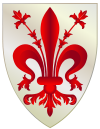
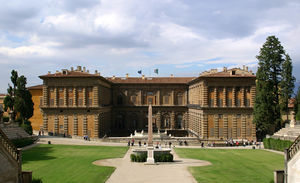
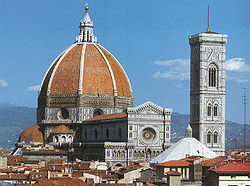
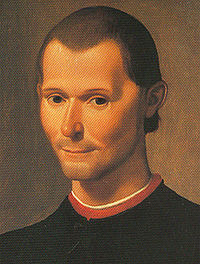
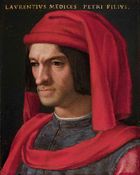
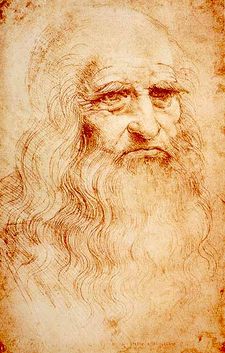
_-_The_Last_Supper_(1495-1498).jpg)


